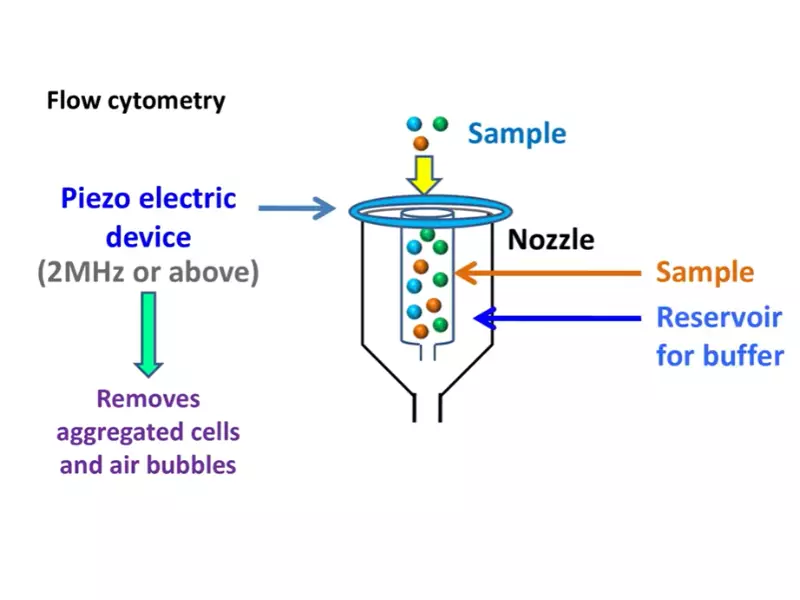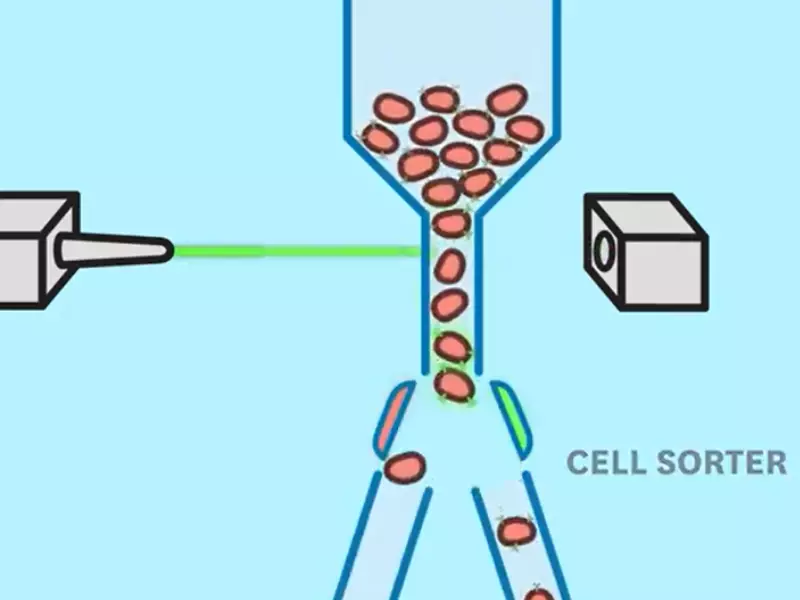Flow cytometry and Fluorescence-Activated Cell Sorting (FACS) are pivotal techniques used extensively in scientific research, especially within the realms of immunology, pathology, and molecular biology. These methodologies have revolutionized the way scientists can analyze and sort cells based on various parameters, including size, complexity, and fluorescence intensity. Despite their shared utility in the scientific community, flow cytometry and FACS serve distinct purposes and are often misunderstood as interchangeable terms.
Flow cytometry is a technique used to detect and measure physical and chemical characteristics of a population of cells or particles. In contrast, FACS is a specialized type of flow cytometry that adds a sorting capability, allowing researchers to physically separate and collect cells of interest based on specific fluorescence characteristics. This crucial distinction underpins the unique applications and advantages each method offers to the scientific and medical communities.
Flow cytometry enables the rapid quantitative analysis of physical and chemical characteristics of cells or particles as they flow in a fluid stream through a beam of light. The method is indispensable for studying the characteristics of cells, including their size, complexity, and the presence of specific markers. FACS extends this functionality by employing fluorescence to sort cells, enabling the collection of cells with desired characteristics for further analysis. This separation is critical for research requiring highly purified cell populations, such as in the development of therapeutic interventions or the study of specific cell types within a heterogeneous population.

Core Concepts
Flow Cytometry
Definition
Flow cytometry is a technological method used to analyze the physical and chemical characteristics of particles in a fluid as it passes through at least one laser. Cell components are fluorescently labeled and then excited by the laser to emit light at varying wavelengths. The intensity of this light is measured to provide information about the size, granularity, and other properties of the particles.
Basic Principles
The basic principles of flow cytometry include the fluidics system, optics, and electronic detection. In brief:
- Fluidics system transports particles in a stream to the laser beam.
- Optics include lasers to excite the particles and lenses to collect the emitted light.
- Electronic detection system converts the light signals into electronic signals that can be analyzed.
Applications
Flow cytometry is widely used in research and clinical practice for various applications such as:
- Immunophenotyping
- Cell sorting
- Disease monitoring
- Genome analysis
FACS
Full Form: Fluorescence-Activated Cell Sorting
FACS is a specialized type of flow cytometry. It provides a method for sorting a heterogeneous mixture of biological cells into two or more containers, one cell at a time, based upon the specific light scattering and fluorescent characteristics of each cell.
How It Works
The process involves:
- Tagging cells with fluorescent markers
- Illumination by lasers to excite the markers
- Detection of the emitted light to identify and sort cells
Specific Applications
FACS is particularly useful for:
- Purifying populations of interest from a mixture of cells
- Cellular biology studies
- Cancer research
Technical Differences
Operational Mechanics
Flow Cytometry Process
- Sample preparation with fluorescent markers
- Passage through a laser beam
- Emission and collection of light signals
FACS Process
- Similar to flow cytometry for detection
- Added mechanism for physically sorting cells based on signals
Analytical Capabilities
Flow Cytometry Analysis
- Quantitative data on cell populations
- Analysis of multiple parameters simultaneously
Sorting Capabilities of FACS
- Selective isolation of cell populations
- High degree of purity in sorted samples
Equipment and Cost
Equipment Used in Flow Cytometry
- Flow cytometer with laser sources, detection systems, and fluidics
Additional Setup for FACS
- Sorting mechanism, often involving electrostatic deflection
- Higher complexity leading to increased cost
Comparative Cost Analysis
- Flow cytometry is less expensive due to simpler setup
- FACS involves higher initial investment and maintenance costs
Application Areas
Research and Development
Usage in Biomedical Research
- Understanding cellular functions
- Investigating molecular mechanisms
Applications in Drug Discovery
- Screening for potential therapeutics
- Evaluating drug efficacy
Clinical Diagnostics
Role in Disease Diagnosis
- Identification of biomarkers for various diseases
- Monitoring of disease progression
Monitoring of Treatment Efficacy
- Assessing response to therapy
- Adjusting treatment strategies based on cellular responses
Industrial Applications
Biotechnology and Pharmaceutical Sectors
- Quality control
- Production of biologics
Environmental Monitoring
- Assessing microbial populations
- Detecting pollutants in water supplies

Advantages and Limitations
Flow Cytometry
Pros
- Versatility: Flow cytometry can analyze many parameters from a single cell, making it a versatile tool for research and clinical diagnostics.
- Speed: It is capable of processing thousands of particles per second, providing quick results.
- Quantitative Analysis: Offers precise quantification of cell populations, allowing detailed analysis of cellular characteristics.
Cons
- Complexity: Requires a significant level of expertise to operate the equipment and analyze the data accurately.
- Cost: While less expensive than FACS, the initial investment and maintenance costs can be high.
- Sample Preparation: Requires meticulous sample preparation to ensure reliability and accuracy of results.
FACS
Pros
- High Precision: Capable of sorting cells with high specificity, allowing for the isolation of populations with precise characteristics.
- Purity: Provides a high degree of purity in sorted cell populations, essential for detailed biological studies.
- Functional Analysis: Enables researchers to collect live cells for further functional analysis, crucial for advanced studies.
Cons
- High Cost: The added complexity and capabilities come with increased costs for equipment and operation.
- Operational Complexity: Requires skilled personnel to operate and maintain, adding to the operational challenges.
- Time-consuming: The sorting process can be slower than analysis-only flow cytometry, impacting throughput.
Selecting the Right Technique
Factors to Consider
- Objective of the Study: Determine whether you need to analyze or sort cell populations.
- Budget Constraints: Evaluate the available budget for equipment purchase and maintenance.
- Sample Size and Type: Consider the size and the type of samples you will be working with.
- Desired Purity of Sorted Cells: Assess the level of purity required for your downstream applications.
Comparative Analysis
- Flow Cytometry is best suited for rapid analysis of cell populations, where sorting is not required, and cost or operational complexity is a concern.
- FACS excels in applications requiring high-precision sorting of cell populations for further analysis or culturing, despite higher costs and operational demands.
Case Studies
Real-world Applications
- Cancer Research: FACS has been pivotal in isolating cancer stem cells for in-depth study, leading to new insights into cancer biology and therapy resistance mechanisms.
- Immunology: Flow cytometry has revolutionized the understanding of immune system dynamics, particularly in disease states, facilitating the development of targeted therapies.
Impact on Scientific Discoveries
- HIV Research: Flow cytometry has been critical in monitoring HIV/AIDS patients, assessing immune function, and guiding therapy decisions, significantly improving patient outcomes.
- Stem Cell Therapy: FACS has enabled the purification of stem cell populations, advancing stem cell research and therapies for a range of degenerative diseases.
Future Directions
Technological Advancements
- Automation: Advancements in automation are reducing the complexity and labor intensity of flow cytometry and FACS, making these techniques more accessible.
- Sensitivity and Specificity: Ongoing improvements in laser and detector technology are enhancing the sensitivity and specificity of both methods.
- Integration of Artificial Intelligence (AI): AI and machine learning algorithms are being integrated to improve data analysis, potentially revolutionizing how we interpret complex datasets.
Emerging Applications
- Personalized Medicine: Both techniques are becoming integral in the development of personalized medicine, enabling the analysis of patient-specific cellular information to tailor therapies.
- Environmental Monitoring: The use of flow cytometry in environmental monitoring is expanding, including the detection and analysis of microorganisms in water sources.
- Agricultural Biotechnology: FACS is finding new applications in agricultural biotechnology, such as the sorting and analysis of plant cells for crop improvement efforts.
Frequently Asked Questions
What is Flow Cytometry?
Flow cytometry is a laser-based biophysical technology employed in cell counting, cell sorting, biomarker detection, and protein engineering, by suspending cells in a stream of fluid and passing them through an electronic detection apparatus. This method allows for the analysis of the physical and chemical characteristics of up to thousands of particles per second.
How does FACS differ from Flow Cytometry?
While flow cytometry is geared towards analyzing multiple physical and chemical characteristics of cells, FACS incorporates a sorting mechanism to separate and collect cells based on specific fluorescence characteristics. This sorting capability is pivotal for applications requiring highly purified cell populations for further research or therapeutic use.
What are the main applications of Flow Cytometry and FACS?
Flow cytometry is widely used for analyzing the expression of cell surface and intracellular molecules, characterizing and defining different cell types in a heterogeneous cell population, assessing the purity of isolated subpopulations, and analyzing cell size and volume. FACS extends these applications by allowing for the physical sorting of cells based on fluorescence, enabling the collection of specific cell types for in-depth study.
Can Flow Cytometry and FACS be used in clinical diagnostics?
Yes, both flow cytometry and FACS have significant applications in clinical diagnostics. Flow cytometry is commonly used in diagnosing health disorders, especially blood cancers, by analyzing blood cells’ physical and chemical characteristics. FACS can further enrich this analysis by isolating specific cell types for detailed examination, which is crucial in understanding disease mechanisms and tailoring individual treatment plans.
Conclusion
Flow cytometry and FACS are cornerstone techniques in modern biomedical research, each with its distinct set of capabilities and applications. While flow cytometry offers a broad analysis of cell populations, FACS provides a targeted approach to isolate and study specific cells, enhancing our understanding of cellular functions and disease mechanisms. Their contributions extend beyond basic research, playing a crucial role in clinical diagnostics and therapeutic development, reflecting their indispensable value in the scientific and medical communities.
The decision between using flow cytometry or FACS hinges on the specific requirements of a study, including the need for cell sorting and the level of detail required in the analysis. As technology advances, the capabilities of these techniques continue to expand, promising new insights into the complexities of life at the cellular level and opening new avenues for disease treatment and prevention.
